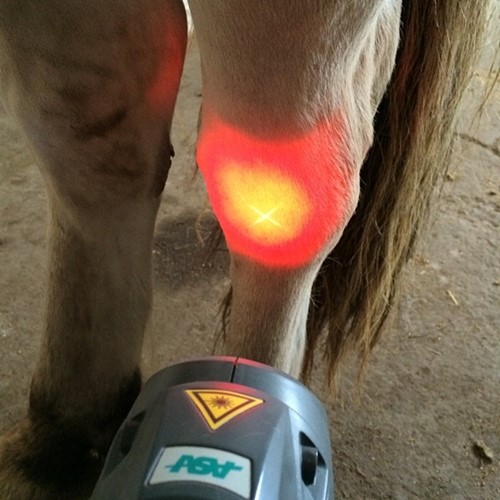Discovering the Holistic Technique of Equine Therapy for Individual Growth
Wiki Article
How Laser Therapy in Horse Therapy Is Transforming Veterinary Care for Equines
Laser treatment has actually arised as a transformative strategy in equine vet treatment, offering a non-invasive service that speeds up recovery and boosts total health. The transportability and versatility of laser treatment gadgets even more highlight their expanding necessity amongst veterinarians.Comprehending Laser Treatment

The technology behind laser therapy is grounded in the concept of photochemistry, where photons are taken in by chromophores within cells, bring about boosted ATP manufacturing and inflection of reactive oxygen types (Equine Therapy). This, consequently, advertises mobile proliferation, reduces swelling, and speeds up healing. Veterinary practitioners make use of different types of lasers, including low-level lasers (LLLT) and high-power Course IV lasers, depending on the particular healing purposes and the nature of the equine problem being treated
Various laser wavelengths and power setups are thoroughly picked to target different cells depths and attain wanted scientific end results. Safety and security protocols are extremely important, as improper use can bring about thermal damage or suboptimal healing impacts. Hence, a thorough understanding of laser therapy's mechanisms and applications is crucial for its reliable implementation in equine veterinary practice.
Advantages for Equine Wellness
The myriad benefits of laser therapy for equine health include boosted healing, pain reduction, and boosted movement. This advanced therapy technique leverages certain wavelengths of light to permeate tissues, boosting cellular feature and advertising fast tissue repair work. The non-invasive nature of laser therapy guarantees very little stress and discomfort for the steed, promoting a smoother healing process.
Improved healing is one of the foremost advantages, as laser treatment increases mobile regrowth and collagen synthesis. Pain reduction is accomplished with the anti-inflammatory results of laser treatment, which lowers swelling and decreases the production of pain-inducing chemicals.
By minimizing inflammation and pain, and enhancing tissue repair work, laser therapy aids in recovering joint feature and muscle mass flexibility. Thus, laser therapy stands as a transformative tool in modern equine vet care.
Common Problems Dealt With
Laser therapy has become a functional treatment option for a variety of common equine problems. Among these, bone and joint injuries are especially open to laser treatment. Equine Therapy. Soft cells injuries, such as tendonitis and tendon strains, advantage from the anti-inflammatory and analgesic impacts of laser treatments, which increase healing and reduce discomfort. Furthermore, laser therapy is reliable for conditions like osteo arthritis, where it assists mitigate joint swelling and promote cells repair work.Wound management is one more location where laser treatment has revealed significant pledge. Chronic wounds or slow-healing abscess can be particularly challenging in steeds, but laser therapy improves mobile regeneration and enhances blood flow, thus quickening the healing process. Laser therapies have actually been effectively utilized in taking care of unguis conditions such as laminitis and abscesses, minimizing discomfort and advertising much faster recovery.

Innovation Behind Laser Therapy
Beyond the myriad problems treatable with laser treatment, the innovation itself values more detailed exam. At the heart of laser treatment is using particular wavelengths of light to penetrate cells and evoke biological reactions. These wavelengths, generally ranging from 600 to 1000 nanometers, are uniquely soaked up by chromophores in the skin, muscle mass, and other cells, initiating a cascade of mobile events.Laser tools utilized in vet medication usually make use of low-level laser treatment (LLLT) or cool laser treatment. Unlike high-powered surgical lasers, these tools operate at lower energy levels, maximizing therapeutic advantages while lessening thermal damages. The energy from the laser light promotes adenosine triphosphate (ATP) production, boosts mobile metabolic process, and accelerates cells fixing processes.

Success Stories and Study

Showcasing the substantial benefits of laser therapy, numerous success stories and situation studies brighten its transformative effect on equine health. One such situation entails a pure-blooded racehorse suffering from chronic tendonitis. Typical therapies produced minimal improvement, however after integrating laser treatment right into the routine, the equine showed considerable decreases in swelling and discomfort within weeks, eventually returning to affordable auto racing.
An additional compelling example features a dressage equine detected with extreme back discomfort, limiting its efficiency. A veterinary group used low-level laser therapy (LLLT) to target the irritated locations, resulting in significant enhancement in flexibility and a significant decrease in discomfort. Over numerous sessions, the equine regained its peak type, showcasing the efficiency of laser therapy in resolving bone and joint problems.
Furthermore, a study performed at a leading equine center examined 50 steeds with numerous soft cells injuries treated with laser therapy. The results were striking: 85% of the steeds demonstrated accelerated recovery times and boosted mobility. These instances emphasize the adaptability and effectiveness of laser treatment in equine medicine, providing a non-invasive, scientifically-backed technique to enhancing recuperation and performance in equines.
Conclusion
Laser treatment is check these guys out changing equine veterinary care by supplying a non-invasive treatment that accelerates recovery, reduces swelling, and minimizes pain. With its efficiency in treating a variety of conditions, from bone and joint injuries to persistent disorders like osteo arthritis, this modern technology significantly enhances equine health and wellness and flexibility. The mobility and versatility of laser therapy even more emphasize its transformative impact on vet techniques, solidifying its duty as a crucial device in modern equine health care.Report this wiki page